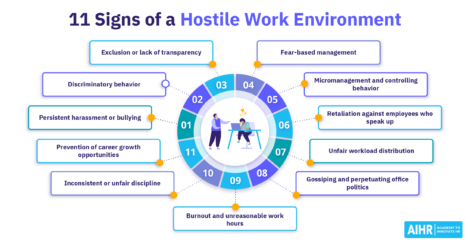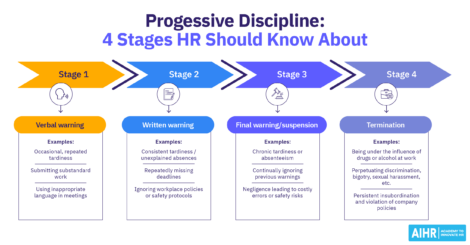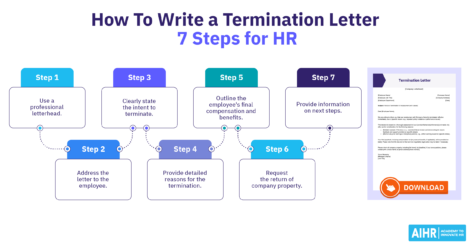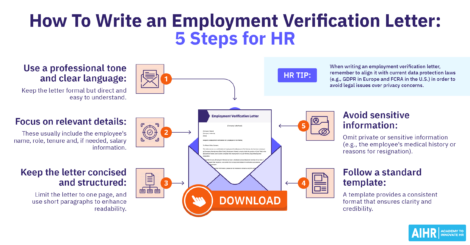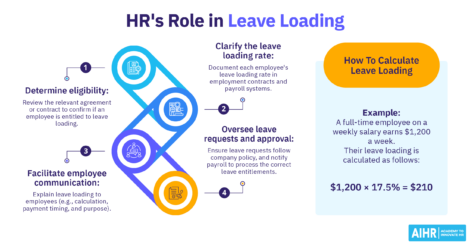[Free] Employment Verification Letter Template and Samples To Write a Professional Letter
Verifying candidates’ past job details is common practice. In fact, 92% of recruiters conduct background checks on candidates. But how you write an employee verification letter can make or break all kinds of decisions, from visa approvals to loan or rental applications.

An employment verification letter is a simple but important document that confirms an employee’s job status, role, and tenure with a company. It is often required as proof of employment and income for bank loans, property rentals, visas, or job applications. HR professionals must ensure these letters are accurate and compliant.
This article discusses the purposes of an employment verification letter and how to write one, and provides a free, customizable template to help you write employment verification letters whenever you need to.
Contents
What is an employment verification letter?
What’s the purpose of an employment verification letter?
Employment verification letter template: Key elements
Free employment verification letter template
5 steps to write an employment verification letter
5 sample employment verification letters
Best practices for writing an employment verification letter
What is an employment verification letter?
An employment verification letter confirms an employee’s job status. HR typically issues it when an employee needs proof of employment for a loan, visa, rental agreement, or background check. The letter includes job title, employee tenure, and sometimes, salary.
Employers may also use it to confirm past or current employment without extra details. This document is essential for professional, legal, and financial situations that require proof of employment or income.
What’s the purpose of an employment verification letter?
Also called a proof of employment letter, this document confirms a job status for official and personal needs. Employers, HR, or financial institutions use it to verify job title, salary, and employment duration.
Here are some common reasons an employee may need an employment verification letter:
Green card application (family- or employment-based)
When applying for a family-based or employment-based green card, applicants must provide financial proof that they can support themselves or that their sponsor can support them. An employment verification letter confirms the job stability and income of the relevant party, strengthening the application.
Visa application (tourist, work, or temporary business visa)
Many countries require proof of employment when processing work, tourist, or business visa applications. An employment verification letter helps demonstrate that the applicant has strong ties to their home country, reducing concerns about non-residents overstaying.
New job opportunities
Potential employers often request employment verification from candidates’ former employers to confirm job details, responsibilities, and tenure. This serves as additional proof of work history, especially for roles that require specific expertise and experience.
Loan or mortgage application
Banks and financial institutions often require proof of employment when assessing loan or mortgage applications. The letter reassures lenders that the applicant has a stable source of income and, as such, is capable of meeting repayment obligations.
Property rental applications
A landlord or property manager may request an employment verification letter to confirm an applicant’s employment status and income stability before approving a rental agreement with them. This is to ensure the tenant can afford to pay the rent each month.
Learn how to develop streamlined HR processes
As an HR professional, you often have to complete various admin tasks, but the key to your success lies in developing HR processes that keep your organization running smoothly.
In AIHR’s HR Generalist Certificate Program, you’ll learn how to create end-to-end HR processes and provide practical guidance on developing your own strategic HR function.
Employment verification letter template: Key elements
Using a standardized template to help you write employment verification letters can help speed up the process while ensuring consistency and accuracy. A good employment verification letter template should include the following key elements:
Employee details
This section covers fundamental information on the employee whose employment needs verification. It typically includes:
- Employee’s full name
- Department (if applicable)
- Job title
- Date of joining the company.
Including these details allows the requesting party to accurately verify the employee’s identity and relevant employment information.
Employer details
The letter must also contain the employer’s details in order to be verified. These details include:
- Company name
- Company address
- Official contact information (phone number and/or email address).
Providing complete employer details helps establish the letter’s authenticity and allows for further verification if needed.
Employment details
This section outlines the key details of the employee’s employment, including:
- Employment start date
- Employment type (full-time, part-time, contract, etc.)
- Salary information (only include if the requesting party requires it).
These details give a comprehensive overview of the employee’s role and work arrangement in the organization.
Purpose of the letter
Clearly state the reason for issuing the letter. Common purposes include:
- Confirmation for immigration applications (green card, visa)
- Verification for loans or mortgage applications
- Proof of employment for prospective employers
- Employment confirmation for rental agreements.
Specifying the purpose ensures the letter meets the requirements of the requesting entity and helps avoid unnecessary revisions.
Signature and company stamp
To authenticate the document, the letter should be signed by an HR representative or other authorized personnel from the company issuing it. It should include:
- Signature from the relevant party
- Printed name and designation of the signer
- Company stamp or official seal (if required)
A signed and stamped letter enhances credibility and formalizes the document for official use.
Free employment verification letter template
AIHR has developed its own customizable employment verification letter template, which you can download for free at the link below.
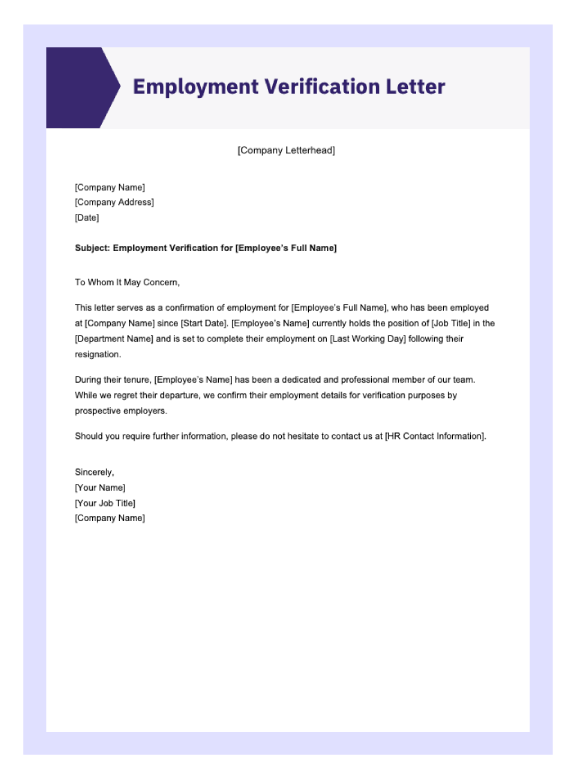
5 steps to write an employment verification letter
When writing an employment verification letter, observe the following steps to ensure clarity, accuracy, and compliance:
Step 1: Use a professional tone and clear language
Keep the letter formal and professional. Avoid overly casual language, as it can make your organization look unprofessional. However, you should also make sure the language you use in the letter is straightforward and easy to understand. This helps minimize confusion and delay in the process.
Step 2: Focus on relevant details
Provide essential employment details, including the employee’s full name, designation and department, employment start date (and end date, if applicable), and employment type (full-time, part-time, contract, etc.). Only include salary information if the recipient has specifically requested it.
Step 3: Keep the letter concise and structured
Organize the letter well and limit it to no more than one page. A simple employment verification letter does not need to be lengthy but should be short and to the point. Use clear, concise, and informative headings and short paragraphs to enhance clarity and readability.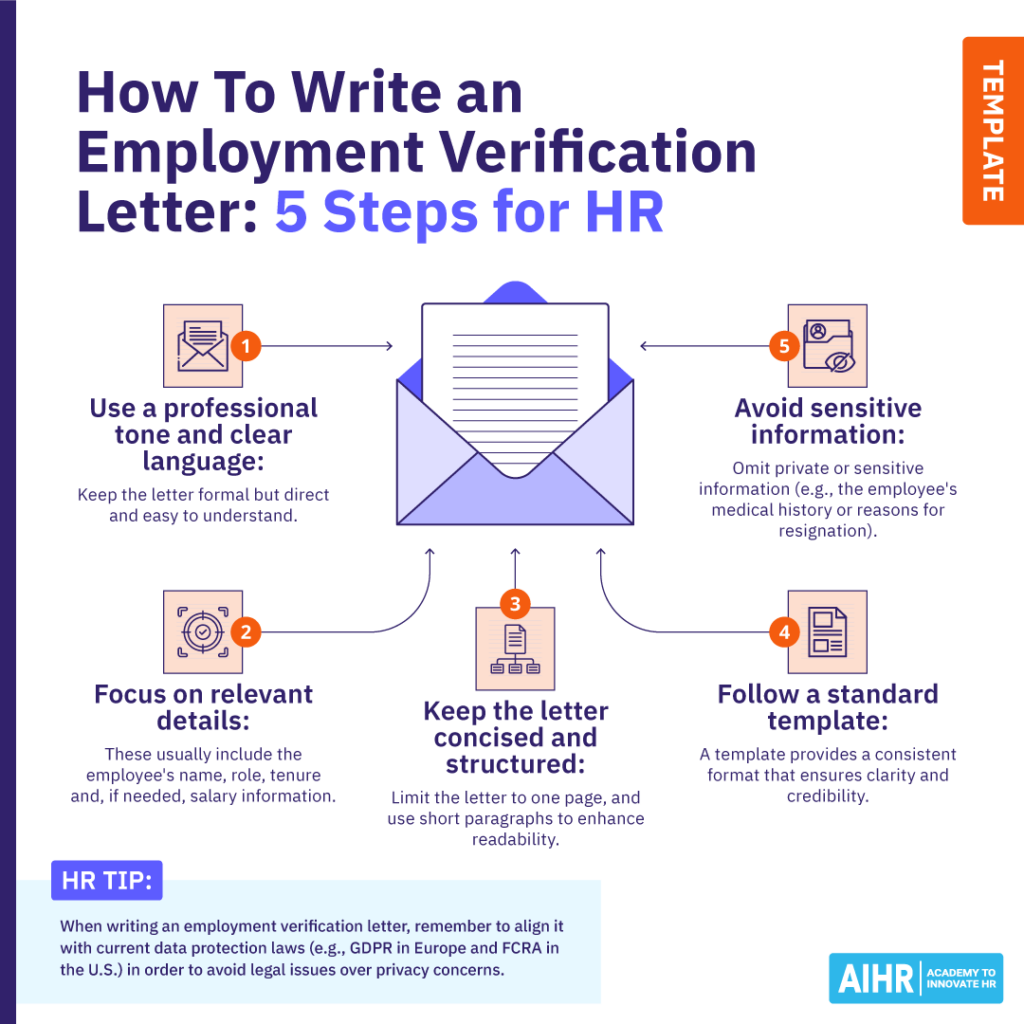
Step 4: Follow a standard template
A template provides a consistent format that ensures clarity and credibility. Your template structure should include details for both employees and employers, an employer’s statement verifying the employment in question, the letter’s purpose, an authorized party’s signature, and the company stamp (if required).
Step 5: Avoid unnecessary personal information
Omit private or sensitive information about the employee. This includes their medical history, the reasons for their resignation or termination of employment contract, and personal opinions of their performance during their tenure. While a medical condition or the reason for the employee leaving may be relevant, only include such details if explicitly required.
5 sample employment verification letters
Below are five sample employment verification letters that cover different scenarios you might have to write such letters for:
Sample 1: Employment verification letter for an outgoing employee applying for a new job
[Company Letterhead]
[Company Name]
[Company Address]
[Date]
To Whom It May Concern,
This letter serves as a confirmation of employment for [Employee’s Full Name], who has been employed at [Company Name] since [Start Date]. [Employee’s Name] currently holds the position of [Job Title] in the [Department Name] and is set to complete their employment on [Last Working Day] following their resignation.
During their tenure, [Employee’s Name] has been a dedicated and professional member of our team. While we regret their departure, we confirm their employment details for verification purposes by prospective employers.
Should you require further information, please do not hesitate to contact us at [HR Contact Information].
Sincerely,
[Your Name]
[Your Job Title]
[Company Name]
Sample 2: Employment verification letter for a former employee applying for a new job
[Company Letterhead]
[Company Name]
[Company Address]
[Date]
To Whom It May Concern,
This letter is to verify that [Former Employee’s Full Name] was employed at [Company Name] from [Start Date] to [End Date]. During their time with us, they held the position of [Job Title] in the [Department Name].
We confirm that [Former Employee’s Name] left the company in good standing. Please note that this letter solely confirms their employment verification and does not serve as a testimonial on their job performance.
Should you require further details, you may contact us at [HR Contact Information].
Sincerely,
[Your Name]
[Your Job Title]
[Company Name]
Sample 3: Employment verification letter for a current employee applying for a loan or mortgage
[Company Letterhead]
[Company Name]
[Company Address]
[Date]
To Whom It May Concern,
This letter confirms the employment status of [Employee’s Full Name], who has been employed with [Company Name] since [Start Date]. They currently hold the position of [Job Title] and are a [Full-time/Part-time/Contract] employee.
Their current annual salary is [Salary Amount], and they are paid [weekly/monthly/biweekly]. This verification is being provided at the request of [Bank/Lender Name] for the purpose of processing a loan/mortgage application.
Should you need further information, please contact us at [HR Contact Information].
Sincerely,
[Your Name]
[Your Job Title]
[Company Name]
Sample 4: Employment verification letter for a current employee applying for a visa
[Company Letterhead]
[Company Name]
[Company Address]
[Date]
To Whom It May Concern,
This letter is to confirm that [Employee’s Full Name] has been employed with [Company Name] since [Start Date] and currently holds the position of [Job Title]. They are employed on a [full-time/part-time] basis and receive an annual salary of [Salary Amount].
This verification is being provided in support of their [visa application/immigration request/work permit application]. [Employee’s Name] remains in active employment, and we foresee no changes to their employment status at this time.
If you require any additional details, please contact us at [HR Contact Information].
Sincerely,
[Your Name]
[Your Job Title]
[Company Name]
Sample 5: Employment verification letter for an employee applying to rent a property
[Company Letterhead]
[Company Name]
[Company Address]
[Date]
To Whom It May Concern,
This letter serves as verification of employment for [Employee’s Full Name], who is currently employed at [Company Name] as a [Job Title] in the [Department Name]. [Employee’s Name] has been working with us since [Start Date], and their employment status is [full-time/part-time/contract].
As of today, their gross annual salary is [Salary Amount], and they receive their wages on a [weekly/monthly/biweekly] basis. This letter is provided upon request for their rental application purposes.
Should further verification be required, please feel free to reach out to us at [HR Contact Information].
Sincerely,
[Your Name]
[Your Job Title]
[Company Name]
Best practices for writing an employment verification letter
As an HR professional, drafting an employment verification letter requires attention to detail, professionalism, and legal compliance. The following best practices ensure each letter serves its purpose effectively:
- Stay updated on labor laws and privacy regulations: Ensure compliance with local labor and privacy laws. Some regions restrict sharing salary history or termination reasons without consent. Consult legal or compliance teams before issuing letters in sensitive cases.
- Be mindful of third-party requests: Confirm the legitimacy of the requester before issuing a letter. If unsure, double-check with the employee, and require employees to request verification through HR.
- Keep a record of the letter: Always retain a copy of the employment verification letter in the employee’s HR file for future reference, compliance checks, or legal protection. Be sure to store records in a secure HR database.
- Confirm details and proofread before sending: Verify names, job titles, employment dates, and salary (if required). Mistakes can cause delays or legal issues, so be sure to have the relevant HR personnel review letters before sending.
- Protect employee confidentiality: Be cautious when handling requests over the phone or email. Ensure the employee has authorized the verification request, and require them to submit a signed request form before you issue a verification letter.
To sum up
An employment verification letter plays a big role in helping employees secure loans, rent homes, apply for visas, or land new jobs. By providing clear, accurate details, you’re giving them the proof they need to move forward with important life decisions.
As an HR professional, you’re also responsible for handling these requests efficiently while protecting employee data. Using standardized templates, verifying third-party requests, and keeping records can make the process smoother and more secure. Doing so reflects positively on your organization, reinforcing professionalism and trust.
Learn more
Related articles
Are you ready for the future of HR?
Learn modern and relevant HR skills, online







